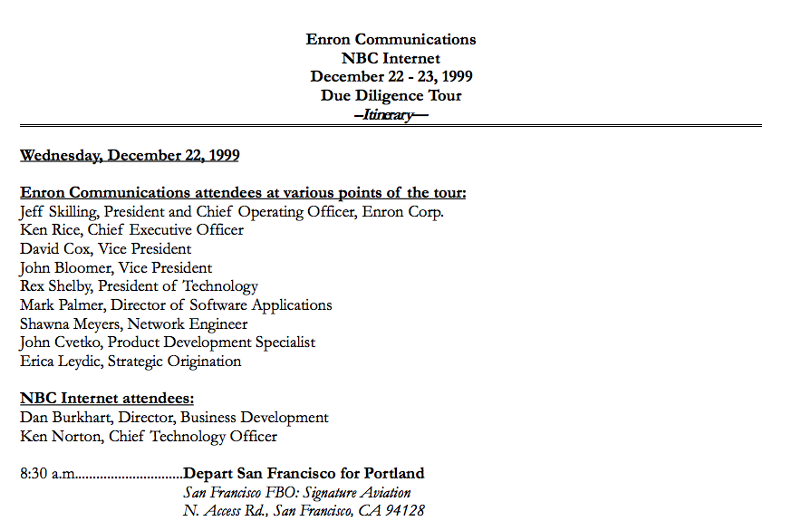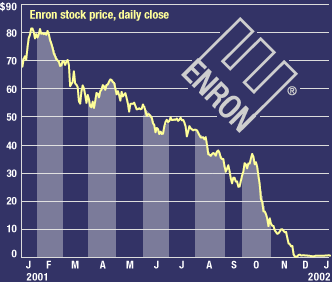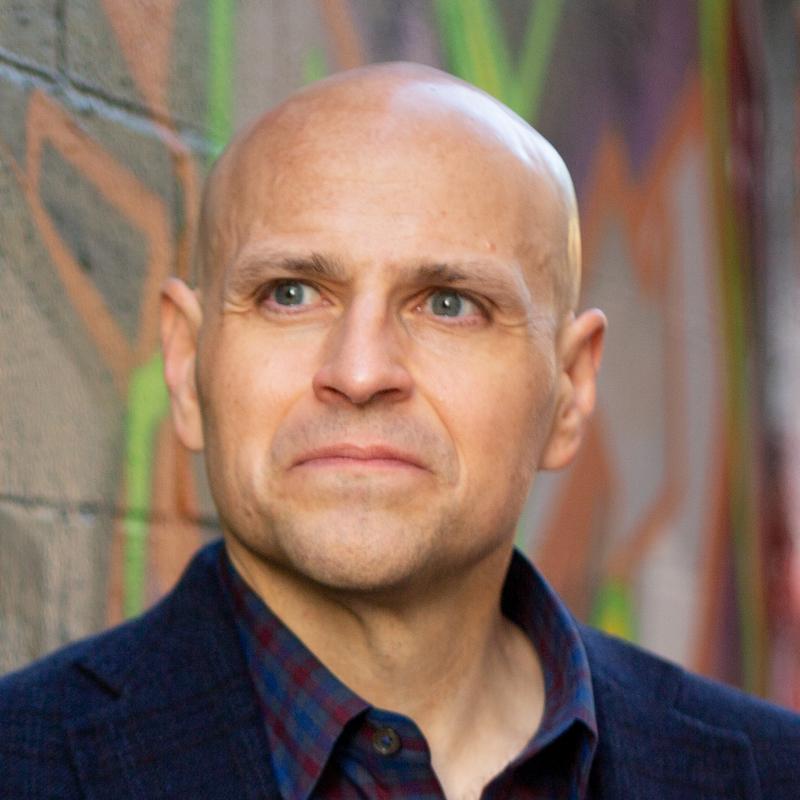
May 1999:
NASDAQ Ends Month at 2470
From 1998 to early 1999 I was the vice president of technology at Snap, a search engine spawned from my old company CNET and part-owned by NBC. In May 1999, in an act of bubble-induced hubris, NBC announced that they were merging Snap with another dot-com, Xoom.com, to form a public company called NBC Internet. NBC would own more than half of the new company. Our market capitalization was slightly less than $4 billion. I was promoted to chief technology officer of the new company. I had just turned 28.
With market expectations driven up, NBC wanted us to make a big push into broadband. Everyone was crazy about broadband, it was the next big thing. The more bandwidth users had coming into their homes, the more they’d want to consume our bandwidth-sucking entertainment services like video and audio. That would lay the groundwork for the entertainment industry’s video-on-demand dream. Conventional wisdom in 1999 had it that consumer demand for bandwidth would quickly outstrip supply. It was a pending disaster as big as Y2K (another contemporary, overhyped catastrophe).
The same month we announced our merger, Enron, the Houston-based natural gas distributor, announced a huge push onto the Internet. They planned to trade excess bandwidth the way they traded oil and gas. To create a market from inefficiencies in bandwidth provisioning and metering. Their pitch was simple — why pay for a persistent 45Mbps Internet pipe when most of the time you didn’t need that much bandwidth? What can you do with the excess capacity between bursts? Well, what if you could trade it like any other commodity? Enron wanted to be a market maker for bandwidth.
On May 20, 1999, Enron announced that their Enron Communications subsidiary (eventually to be known as Enron Broadband Services, or EBS) would be creating a global commodities market for bandwidth. In order to make this work, Enron needed a substantial backbone for itself. It also needed to connect (or “peer”) with each of the ISPs and telcos that would be offering bandwidth in the market. The peering would take place at eight multimillion dollar pooling points owned by Enron. Once the networks were in place, a customer could buy or sell excess capacity in Enron’s market. A buyer could go to Enron, say “I need 45Mbps of bandwidth for the next five hours, and here’s what I’m willing to pay.” Then Enron would handle the provisioning. The stock market loved the idea. Overnight Enron went from stodgy industrial company to tech darling. Their stock almost doubled over the next six weeks, adding $23 billion to Enron’s market capitalization.
Summer and Fall 1999:
NASDAQ Approaches 3000
To execute on NBCi’s broadband strategy, we needed bandwidth, and lots of it. We needed fat pipes to connect our datacenters to Internet backbones so we could efficiently move our heavyweight content around. There were plenty of players willing to give it to us. Companies like Level 3, Global Crossing, Williams, and Qwest were scrambling billions of dollars on global fiber networks to handle the predicted demand. Telcos, cable companies, and CLECs, for their part, ramped up plans to bring DSL and cable Internet to consumers (“the last mile”).
But there was a problem. The design of the Internet just didn’t lend itself to delivering high quality streaming media to desktops. The beauty of TCP/IP was its “best effort” design. We’ll get your packets to their endpoint, in one piece, but we won’t make any guarantees how long that will take or in what order they’ll arrive. That was terrific for stuff like email or web pages, but not so good for video. A 500 millisecond delay in the delivery of an email didn’t concern anybody, but a half-second frame skip during an episode of Friends would frustrate viewers. And if we’re going to run out of bandwidth, the networks will be stretched to capacity, exacerbating the problem and jeopardizing video-on-demand.
To overcome this obstacle, technology companies were investing in something called network quality of service (QoS). QoS starts from a simple premise: we should make routers and switches smarter about the packets they’re moving about. Given the choice between forwarding a streaming video packet or an email packet, they should hold up the email to make sure the video gets through unscathed. It’s the network equivalent of pulling aside on the highway to let an ambulance pass.
Enron to the rescue again. In 1998, they purchased a software company called Modulus, located in Houston. Modulus started as a Rice University-NASA joint venture to build software for the space shuttle. Somewhere along the way (it’s not clear when) they started working on network QoS. When Enron approach NBCi in Fall 1999, they boasted not only a just-about-to-launch network backbone but industry-leading QoS to boot. They called it the Enron Intelligent Network.
December 21-23, 1999:
NASDAQ Hits New High of 3969
I wasn’t involved in the early discussions with Enron, but I had heard that they were going well. The business development guys kept getting more and more excited. There was talk not just of a partnership, but of a $100 million investment in NBCi. The operating agreement would give us access to their QoS network and the ability to offer full motion, full screen video-on-demand to consumers.
On December 21, 1999 we announced that NBCi was investing in a DSL company called Telocity. This was a big part of our “last mile” strategy. The pieces were falling into place. The Enron discussions were really heating up and it was time to do the technical “due diligence.” That was usually the point in a deal where I came in. Visit the potential partner, kick the tires, ask the difficult questions, make sure they’re not idiots, and determine if their technology did what they said it did. They’d do the same to us. From the beginning it became obvious that the Enron due diligence trip wasn’t going to be typical.

When we got the agenda from Enron (here’s a PDF of the itinerary) we realized they had big plans. I, along with our BD guy, would be hopping on their corporate jet in San Francisco, flying up to Portland to check out their operations center, flying down to Los Angeles to see their datacenter, then zooming to Houston to check out their headquarters and meet Enron president Jeff Skilling.
Now, I was a 28 year-old kid from a lower middle-class upbringing. I’d never been on a private jet. I couldn’t contain my excitement.
We arrived at the San Francisco airport at 8 a.m. on the morning of December 22, 1999. Sitting there on the tarmac was a beautiful Falcon 900. It turns out this was the same jet that Ken Lay once sent empty to France to pick up his daughter. The jet cost Enron $30 million and some $5200 an hour to operate. (If that estimate is correct, my trip would end up costing Enron about $60,000 in flight costs alone, not including dead legs.)
When we boarded the plane, we were greeted by our Enron hosts, David Cox and John Bloomer. The pilot welcomed us aboard. I remember asking him if he was actually an Enron employee. He said, “I sure am, and proud to be one.” I couldn’t believe that this company was so rich it could afford its own air force. The inside of the plane was immaculate. Huge leather seats, plush couches, a catered spread. Every drawer and cupboard was stuffed with goodies. Snickers bars, peanuts, beer, wine, and cigars. We felt like kings.
I realized that day why most people hate business travel. It’s not the flying that wears you out, it’s the airports. Traveling isn’t so bad when you’re not standing in line for security, lugging your suitcase to the gate, or sitting in a hot, stuffy plane waiting for takeoff. A couple of minutes after we boarded the pilot asked us if we were ready. When we said yes, he prepared for takeoff. I could get used to this.
Portland, Oregon:
Enron Broadband Services Headquarters
We turned north toward Portland. In 1997, Enron bought Portland General Electric (PGE), a staid electric utility founded in 1889. Enron had recently redirected some of the best technical talent from PGE and surrounding companies to the EBS business. Portland was the network operations center (NOC) for the burgeoning bandwidth trading operation and the headquarters of the EBS subsidiary.
After landing in Portland we were whisked to an old, brick building that was originally PGE’s base of operations. I thought it was curious that such a high-tech operation be based at such an old economy location. The brick “Portland General Electric” masthead seemed quaint. Inside we were greeted by a state-of-the-art operations center. Giant flat-paneled displays showed the health of far-flung datacenters. Gigantic glowing meters communicated available capacity. It became clear that Enron wanted to impress us. At every step of the trip they would tell us how much everything cost: “this NOC alone cost $20 million,” or “we’ve spent easily $1 billion on network hardware to date.” The Enron executives made it clear they were willing to outspend anyone and everyone to own the market for bandwidth. This part of the tour would set the precedent for the next two days — Enron boasting about how much money they were spending. There wouldn’t be much talk about innovations in the technology or the quality of the team; this was all about money and accumulated capital assets.

Los Angeles, California:
Enron’s Datacenter
Our next stop was Los Angeles, to visit one of Enron’s points-of-presence (POP). The destination was LA’s “carrier hotel,” a 30-story building containing very few offices but hundreds of datacenters. It’s here that telcos and ISPs come to peer their networks. Chances are that every time you load a web page, your data goes through a place like this. The building contained floor after floor of switches, routers, and servers. It was here that Enron was setting up one of their POPs. They’d sit smack dab in the middle of all of these networks, making it easy to provision and reroute traffic anywhere.
The first thing I noticed when our limo pulled up was the asphalt. It was an absolute mess. The street had been dug up and trenched for fiber more times than you could count, and spray-painted markings of all colors and symbols filled every inch of pavement.
We ascended the elevator to Enron’s floor, and walked to their datacenter. Enron had taken over a medium-sized room, probably big enough to accommodate 50 racks. The room was entirely empty except for two big hulking, humming masses in the corner. They were brand new Lucent all-optical switches. Each one was the size of two full cabinets. They had 256 optical ports down the front. The switches each had a capacity of 10 Terabits. It was unthinkable in 1999.
Cox quickly announced that the switches had cost $3 million each, and that they were the first ones Lucent had shipped — nobody else could get them yet. Amazingly, two more were on the way and there were plans to eventually fill the room with these behemoths. “We’re going to invest easily $100 million dollars on each POP,” he announced, “and there will be six others in different cities.” We couldn’t believe the scale.
Once my amazement died down, I noticed something curious. The switches were cool, alright, but there was something unusual. There weren’t any cables connected to the ports except for one lone OC-3 cable. That left 511 empty ports. “When are you going to hook those up?,” I asked. “Very soon,” was the terse answer, as we were marched into the next room.
Houston, Texas:
EBS Engineering and Staging Facility
At just after 5 p.m., we departed Los Angeles for Houston. The day’s official business was over, so the Enron execs broke out the booze. We chowed on catered sandwiches and fine wine. Our little entourage had grown from four to six since San Francisco. I don’t remember a lot of the conversation, but the team was friendly, intelligent, and genuinely interested in doing a deal with NBCi. They were clearly proud of their company and its accomplishments, and beamed whenever we expressed astonishment at the magnitude of their operations.
We touched down a little before 10 p.m. Houston time. Waiting limousines took us to our hotel, The Houstonian, a luxurious wood-paneled building in the woods near downtown. We needed a good night’s sleep because the limo would be waiting to take us to headquarters at 8:30 a.m. the next morning.
In the morning, the limo drove us to Enron’s “Shepherd Location,” the staging center for the POP buildout effort. Officially it was known as the EBS Engineering and Staging Facility. Here, new machines were configured and tested and sent out across the country to the POPs. These servers would handle the QoS aspect of the Enron Intelligent Network.
The building was basically a large warehouse. Inside, Ken Rice, the Enron Communications CEO, and Rex Shelby, president of technology, greeted us and demonstrated the provisioning process. A spanking new Sun server arrived and was built up. Then, engineers loaded the QoS software and tested it. Finally, the server was boxed back up and sent on its way.
The shelves were stacked to the rafters with unopened cardboard boxes with the Sun logo printed on the side. Rice made a point of mentioning how much all of the gear had cost Enron, but I can’t remember what number he quoted. (Now, in retrospect I have no way of knowing if there was anything in those boxes, but they sure looked impressive.)
Within a few minutes, a blond, smiling man wearing an Enron fleece jacket walked in. “Hi, I’m Jeff Skilling,” he announced, “president and COO of Enron.” He looked much younger than I’d expected. I watched the way the other Enron employees acted around Jeff. They were obviously in awe of him.
Jeff gave a quick speech about how Enron was going to revolutionize the bandwidth industry just as they forever changed the way natural gas was bought and sold. He had a solid grasp of the technology. I remember him making some joke about deregulation. He told us how excited he was about the prospects of working with NBCi. He reminded us how much they needed us, how dependent they were on the “content plays” to drive demand for their bandwidth. He also revealed that Enron was in talks with Blockbuster to bring a video-on-demand service to the market (that deal would be announced the following July). And, of course, he made a point of reminding us how much money Enron had invested, and would continue to invest, in the bandwidth business.
Skilling would later say “I am not an accountant” when asked by a Senate panel about Enron’s financial dealings and balance sheet woes. He sure seemed to know a lot about financial facts and figures the day I met him.
From 1999 until his resignation in August, 2001, Jeff Skilling sold 1.12 million shares for a profit of more than $67 million. Skilling was indicted in February 2004 and charged with 35 counts of securities and wire fraud. The charges had a maximum penalty of 325 years in prison and $80 million in fines. In 2006 he was convicted and sentenced to a 24-year prison term and fined $45 million. He was released from federal custody in 2019.
Ken Rice, the EBS CEO who showed us around the warehouse, pleaded guilty to fraud and became a cooperating witness for the government. He pleaded guilty and served a 27-month sentence.
Rex Shelby, the third Enron executive we met in the warehouse, was charged with fraud, conspiracy, and money laundering but ended up pleading guilty to only one count of insider trading and was sentenced to two years probation.
Houston, Texas:
EBS Software Development Facility
From the warehouse we drove to the “Robinhood Location,” a small office complex in the shadow of Rice University. Here, the former Modulus team was developing the QoS software for Enron’s network.
We didn’t spend a lot of time there, and I suspect they scheduled this visit at the end of the trip to ensure we’d be pressed for time. That meant we wouldn’t have time to ask lots of questions, or to really dig into the technology. We had less than an hour before we were due back at the airport for the flight back to San Francisco.
The demo was given by a young, enthusiastic Enron engineer. To show the QoS capabilities, he queued up the movie Matrix on a display at full-screen resolution. “We use the Matrix because it’s every geeks’ favorite film,” as if it needed explaining. The movie, he said, was being streamed from another server in the same facility. He clicked a button and the crisp video went fuzzy. This button, he announced, flooded the network with simulated traffic. Network capacity was now over 99%, and Keanu Reeves popped and blurred as the routers struggled to keep the packets moving. “Now,” he said, “I’ll turn on the QoS.” With the flip of a switch the film returned to its pristine, watchable state.
Hmm, I thought. Who knows what’s actually happening behind the scenes? If the QoS software is working, it’s definitely impressive. But how it performs in this highly controlled environment doesn’t really tell us much about how it’ll do in the real world. Plus, it would be just too easy to fake a demo like this. I’d done plenty of last-minute demos of not-ready-for-primetime technology, and I knew the ropes.
I was able to ask about five minutes worth of questions before we ran out of time. For one, I asked when the technology would be ready. “It’s ready now,” he answered. We said our goodbyes, took possession of our new Enron fleeces (just like Jeff’s!), and climbed into the limo for the ride back to the airport.
We’d be returning home to San Francisco by ourselves, and then the Falcon 900 would deadhead back to Houston. Just the two of us, the Falcon 900, the snacks and the booze on the flight back to San Francisco. It was a pretty awesome flight.
Enron VP John Bloomer, one of our tour guides, stated in testimony this year that the network software was at least a year away from being functional in late 1999. He found ”disturbing things” when he examined the technology shortly after joining EBS in 1999. He testified that he warned executives in November and December 1999 of the shortcomings. The federal government accuses Enron executives of ignoring those warnings when they misrepresented the technology’s capabilities in the January 2000 earnings call.
Shawna Meyer (referred to as “Shawna Meyers” on the agenda), would testify before a jury that the technology demonstrated for me that day was nothing more than “Pixie dust… It was like that little frog with the hat and cane.” When asked why she didn’t clue us in, she said it would have been a “career-limiting move.”
May 16, 2005:
NASDAQ 1976
I wish I could say that when we got back to San Francisco I reported that Enron’s whole presentation was a cheap facade, or that the technology was fraudulent. But I didn’t. I was dazzled by their toys and yes, I was impressed with their executives (especially Skilling). I won’t pretend there was much “due diligence” performed on that trip — Enron made sure there wasn’t. The whole purpose of the visit was to overwhelm us with their riches, to say “we can outspend anyone on earth and you will do this deal with us or we will do it with your competitor.”
Shortly after the trip I bought their stock. The stock would double before things fell apart. But I wouldn’t sell until October 2001 at which point I’d lost 50% of my money. Compared to the Enron employees who lost their life savings, I consider myself lucky.
The NBCi-Enron deal never materialized. I’m not sure why or how it unraveled. After I filed my technical evaluation I didn’t participate in any more discussions. There is a somewhat happy end to the story however. In late 2001, at the height of the Enron media hysterics, I sold my now historic Enron fleece on eBay for more than $100.

